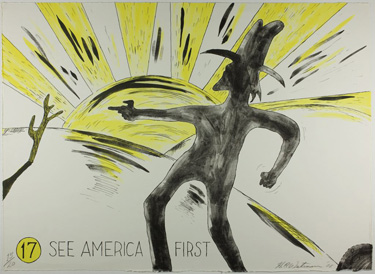H.C. Westermann at the Art Institute of Chicago
By Beth Capper
 Horace Clifford Westermann is a complicated figure in the history of American art, especially in Chicago, as is revealed by the exhibition Chicago Stories: Prints and H.C. Westermann–See America First at the Art Institute of Chicago. Cliff, as he was known to his friends, never quite fit into any specific scene or genre. His work straddled New York Pop and California Funk art, and he has been cited both as a part of and as a pre-cursor to the Chicago Imagists, making art at the same time as Leon Golub and Nancy Spero, while also cited as a major influence on a younger generation of Chicago artists such as Ed Paschke and Jim Nutt.
Horace Clifford Westermann is a complicated figure in the history of American art, especially in Chicago, as is revealed by the exhibition Chicago Stories: Prints and H.C. Westermann–See America First at the Art Institute of Chicago. Cliff, as he was known to his friends, never quite fit into any specific scene or genre. His work straddled New York Pop and California Funk art, and he has been cited both as a part of and as a pre-cursor to the Chicago Imagists, making art at the same time as Leon Golub and Nancy Spero, while also cited as a major influence on a younger generation of Chicago artists such as Ed Paschke and Jim Nutt.
The lithographs in his See America First series are a focal point of a wider exhibition exploring Chicago’s legacy of printmaking at the Art Institute. This suite of 18 lithographs was made in 1968 during an eight-week residency at the Tamarind Lithography Workshop in Los Angeles. Influenced by his cross-country travels around the United States with his wife Joanna Beall, See America First documents his iconoclastic impressions of a country which he both adored and was scathingly critical of. Themes common throughout Westermann’s art practice appear in the series, such as ships, houses and his cyborgian amalgams of humans, machines, animals, and landscapes.
In terms of style and tone, the lithographs lie somewhere between the extremes of his sculptures and his drawings. His sculptures are intensely wrought yet strangely amorphous–constructed lovingly by hand from wood and other found materials. Conversely, his drawings often appear scrappy, dashed out and passed on to friends and family as gifts or illustrated letters (many of Westermann’s works, especially his drawings, were given away instead of sold for commercial value). In general, his oddball aesthetic is humorous and grave in equal measure, engaging both camp and pop style with his reclamation of vernacular culture and use of commodity imagery.
 Throughout his ouevre, Westermann heavily alluded to a certain discomfort with the common morals of the 1950s, taking pleasure in mocking depictions of America, and often pushing against the limitations of these morals with scatalogical, lewd and (homo)erotic allusions. Although Westermann has stated that See America First was a tribute to the bountiful wonders America has to offer, the lithographs themselves suggest his tongue was partially in cheek.
Throughout his ouevre, Westermann heavily alluded to a certain discomfort with the common morals of the 1950s, taking pleasure in mocking depictions of America, and often pushing against the limitations of these morals with scatalogical, lewd and (homo)erotic allusions. Although Westermann has stated that See America First was a tribute to the bountiful wonders America has to offer, the lithographs themselves suggest his tongue was partially in cheek.
The most erotic of these lithographs are also perhaps the most striking of the collection. For example, “Untitled #8 (See America First IX)” depicts a woman’s curvaceous buttocks with a palm tree planted squarely between the cheeks, apparently sodomizing her. This image points to a subtle queerness that is inflected elsewhere in Westermann’s objects and drawings. On a more heteroerotic note, “Untitled #10 (See America First XI)” is an odd pin-up of sorts, where an anonymous woman’s naked body sprawls across a vast ocean and a sky with twinkling stars. Her body merges with the landscape so that her breasts become a mountain range. The word “First” is written as “1st” in the top right-hand corner of this lithograph, suggesting this lewd landscape as a proposal for 1st class postal stamps. All these elements together suggest that looking at pornographic imagery is as commonplace as gazing at the horizon.
Westermann applied his workmanlike ethic to lithography, cutting and printing all of his relief prints in his studio himself. In addition, he also crafted wooden boxes to keep these lithographs in, shunning the boxes available at Tamarind as being too expensive and “real slick looking”–an aesthetic that Westermann, with his DIY sensibilities, opposed. The display of one of these boxes among the lithographs is one of the major highlights of this exhibition, and provides a little of the much needed exposition of Westermann’s sculptural practice that feels pointedly absent here. The box itself is beautifully crafted from plywood and branded with an image of flexing muscles (recalling Westermann’s days in the Marine Corps) with the words “Le Bandeur” inscribed like a tattoo, a colloquialism for “up-yours” that was an homage to the ironic daily greeting exchanged between the men at Tamarind.
 Chicago Stories: Prints and H.C Westermann–See America First adds some much needed exposure to the work of scholars Dennis Adrian (who has been writing about Westermann since the 1960s) and Richard A. Born, who were together responsible for rediscovering Westermann’s work in lithography. However, while the additional and extensive history of printmaking in Chicago explored in the rooms adjacent to the See America First suite is fascinating, it seems unnecessary as a means of situating Westermann’s work within a tradition. His body of work in its entirety is considered to stand outside of other trends in art-making of this period. What is much needed in addition to the lithographs is the presence of some of his wooden objects as a means of understanding his practice (and the museum could start by retrieving “Mysteriously Abandoned New Home” from the kid’s playpen in the basement).
Chicago Stories: Prints and H.C Westermann–See America First adds some much needed exposure to the work of scholars Dennis Adrian (who has been writing about Westermann since the 1960s) and Richard A. Born, who were together responsible for rediscovering Westermann’s work in lithography. However, while the additional and extensive history of printmaking in Chicago explored in the rooms adjacent to the See America First suite is fascinating, it seems unnecessary as a means of situating Westermann’s work within a tradition. His body of work in its entirety is considered to stand outside of other trends in art-making of this period. What is much needed in addition to the lithographs is the presence of some of his wooden objects as a means of understanding his practice (and the museum could start by retrieving “Mysteriously Abandoned New Home” from the kid’s playpen in the basement).
AIC’s inability to let Westermann’s work stand alone does disservice to him and the other works in the exhibition. While the Smart Museum put together an excellent exhibition from its H.C Westermann study collection a year and a half ago, AIC has yet to have a comprehensive retrospective of Westermann’s works, despite the fact that Westermann was a student at SAIC in the 1950s. It’s time to stop sidelining Westermann and give his work its due.
Chicago Stories: Prints and H.C. Westermann—See America First is on view at the Art Institute of Chicago from May 16 – August 15, 2010, in Galleries 124-127, 111 S Michigan Ave







